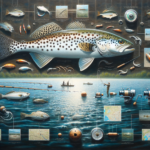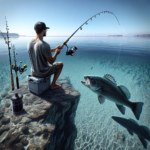Fishing Tips on How to Catch Speckled Trout (Spotted Seatrout)

Introduction
Speckled trout, also known as spotted seatrout, are a popular target for sport and recreational anglers. Known for their distinctive spots and vibrant coloration, these fish are not only a joy to catch but also provide a thrilling challenge for anglers of all skill levels. This article will delve into the various aspects of catching speckled trout, from understanding their behavior and habitat to mastering the best fishing techniques and gear. Whether you’re a seasoned angler or a beginner, these tips will help you improve your chances of landing this prized species.
Fish Species Overview
Description
Speckled trout are easily recognizable by their elongated bodies, which are typically silver with a greenish or bluish tint on the back. They are adorned with numerous black spots that run along their sides and extend onto their dorsal and tail fins. Adult speckled trout can grow up to 39 inches in length and weigh as much as 17 pounds, although the average size is usually between 1 to 5 pounds.
Habitat
Speckled trout thrive in a variety of environments, including freshwater, saltwater, and brackish waters. They are commonly found in coastal areas, estuaries, bays, and lagoons. These fish prefer shallow waters with sandy or muddy bottoms and are often found near seagrass beds, oyster reefs, and other underwater structures. Popular regions for speckled trout fishing include the Gulf of Mexico, the Atlantic coast of the United States, and the coastal waters of the southeastern states.
Behavior
Speckled trout are opportunistic feeders, primarily preying on small fish, shrimp, and crabs. They are most active during dawn and dusk, making these times ideal for fishing. Spawning typically occurs from late spring to early summer, during which time they move to shallow waters to lay their eggs. Anglers often face challenges such as the fish’s wariness and their tendency to be more active during low-light conditions.
Best Time to Catch Speckled Trout
Seasonal Considerations
The best time to catch speckled trout varies depending on the region, but generally, the spring and fall months are considered optimal. During these seasons, water temperatures are moderate, and the fish are more active and feeding aggressively.
Time of Day
Speckled trout are crepuscular feeders, meaning they are most active during the early morning and late evening hours. Fishing during these times can significantly increase your chances of success.
Weather Conditions
Ideal weather conditions for speckled trout fishing include overcast skies and calm waters. Cloudy days can be particularly productive as the fish are less likely to be spooked by shadows and movements on the water’s surface.
Top Fishing Techniques for Speckled Trout
Technique 1: Live Bait Fishing
Using live bait such as shrimp, mullet, or pinfish is highly effective for catching speckled trout. Rig the bait on a popping cork or a free-line setup to keep it at the desired depth. The natural movement of live bait is irresistible to speckled trout, making this technique particularly successful.
Technique 2: Soft Plastic Lures
Soft plastic lures, such as paddle tails and jerk baits, mimic the appearance and movement of small fish and shrimp. These lures can be fished using a variety of techniques, including jigging and slow retrieval. The versatility and lifelike action of soft plastics make them a favorite among speckled trout anglers.
Technique 3: Topwater Lures
Topwater lures, such as poppers and walk-the-dog baits, create surface commotion that attracts speckled trout. This technique is particularly effective during low-light conditions when the fish are actively feeding near the surface. The visual excitement of a topwater strike adds an extra layer of thrill to the fishing experience.
Pro Tips
- Match the hatch by using baits and lures that resemble the local forage species.
- Vary your retrieval speed and technique to find what triggers strikes.
- Use fluorocarbon leaders to reduce visibility and increase your chances of hooking wary fish.
Recommended Gear for Catching Speckled Trout
Fishing Rod and Reel
A medium-light to medium-action spinning rod paired with a 2500 to 3000 series reel is ideal for speckled trout fishing. This setup provides the sensitivity needed to detect subtle bites while offering enough power to handle larger fish.
Fishing Line
Braided line with a 10-20 lb test is recommended for its strength and sensitivity. Pair it with a 12-20 lb fluorocarbon leader to reduce visibility and improve your chances of hooking fish.
Hooks and Baits
Use size 1/0 to 3/0 hooks for live bait fishing. For artificial lures, jig heads ranging from 1/8 to 1/4 ounce are suitable. Popular baits include live shrimp, mullet, and pinfish, as well as soft plastic lures and topwater plugs.
Additional Gear
- Popping corks to keep live bait at the desired depth.
- Sinkers to help control the depth of your bait or lure.
- Landing net to safely land and handle the fish.
Best Locations to Find Speckled Trout
General Locations
Speckled trout are commonly found in coastal waters, estuaries, bays, and lagoons. Look for areas with seagrass beds, oyster reefs, and other underwater structures that provide cover and attract baitfish.
Specific Regions
Popular regions for speckled trout fishing include the Gulf of Mexico, particularly the coasts of Texas, Louisiana, and Florida. The Atlantic coast, from the Carolinas to Florida, also offers excellent speckled trout fishing opportunities.
Common Mistakes to Avoid
Mistake 1: Using the Wrong Gear
Using gear that is too heavy or too light can hinder your success. Ensure you have the appropriate rod, reel, line, and hooks for speckled trout fishing.
Mistake 2: Ignoring the Tides
Tides play a crucial role in speckled trout behavior. Fishing during the wrong tide can result in poor catches. Pay attention to tidal movements and plan your fishing trips accordingly.
Mistake 3: Overlooking Structure
Speckled trout are often found near underwater structures such as seagrass beds, oyster reefs, and drop-offs. Failing to target these areas can reduce your chances of success.
Catch and Release Tips
Importance of Conservation
Practicing catch and release helps ensure the sustainability of speckled trout populations. Ethical fishing practices contribute to the long-term health of the species and the overall ecosystem.
Proper Handling Techniques
- Use wet hands or a wet cloth to handle the fish to avoid removing their protective slime coating.
- Minimize the time the fish is out of the water to reduce stress.
- Use barbless hooks or crimp the barbs to make hook removal easier and less damaging.
Legal Considerations
Be aware of local regulations regarding size limits, bag limits, and protected areas. Adhering to these rules helps maintain healthy fish populations and ensures a sustainable fishery for future generations.
Frequently Asked Questions (FAQs)
What is the best bait for catching speckled trout?
The best bait for speckled trout varies depending on the season and local conditions. Live shrimp, mullet, and pinfish are highly effective natural baits. Soft plastic lures and topwater plugs are also popular artificial options.
Where is the best place to fish for speckled trout?
Speckled trout are commonly found in coastal waters, estuaries, bays, and lagoons. Look for areas with seagrass beds, oyster reefs, and other underwater structures. Popular regions include the Gulf of Mexico and the Atlantic coast of the United States.
What time of day is best for catching speckled trout?
Speckled trout are most active during the early morning and late evening hours. Fishing during these times can significantly increase your chances of success.
What type of fishing line should I use for speckled trout?
Braided line with a 10-20 lb test is recommended for its strength and sensitivity. Pair it with a 12-20 lb fluorocarbon leader to reduce visibility and improve your chances of hooking fish.
Do I need a special fishing license to catch speckled trout?
Fishing license requirements vary by region. Check local regulations to determine if a special license is needed. Be aware of size limits, bag limits, and any special permits required for speckled trout fishing.
What is the best technique for catching speckled trout?
Live bait fishing, using soft plastic lures, and topwater lures are all effective techniques for catching speckled trout. Each method has its advantages, and experimenting with different techniques can help you find what works best in your area.
Are there any specific weather conditions that improve the chances of catching speckled trout?
Overcast skies and calm waters are ideal weather conditions for speckled trout fishing. Cloudy days can be particularly productive as the fish are less likely to be spooked by shadows and movements on the water’s surface.
Can I catch speckled trout from the shore, or do I need a boat?
Speckled trout can be effectively caught from both shore and boat. Shore fishing can be productive in areas with access to shallow waters, such as piers, jetties, and beaches. A boat allows you to reach deeper waters and more remote fishing spots.
How can I improve my chances of landing a big speckled trout?
To catch larger speckled trout, use bigger baits and lures that mimic the size of their natural prey. Focus on fishing during low-light conditions and target areas with abundant underwater structures. Patience and persistence are key to landing trophy-sized fish.
What should I do if I plan to release speckled trout after catching them?
Practice ethical catch and release techniques to ensure the fish’s survival. Handle the fish with wet hands, minimize the time out of the water, and use barbless hooks for easier release. Follow local regulations regarding size limits and protected areas.
Conclusion
Speckled trout fishing offers a rewarding experience for anglers of all skill levels. By understanding the fish’s behavior, habitat, and optimal fishing techniques, you can significantly improve your chances of success. Remember to use the recommended gear, target the best locations, and practice ethical catch and release methods. With these tips in mind, you’re well on your way to landing more speckled trout and enjoying the thrill of the catch. Happy fishing!




